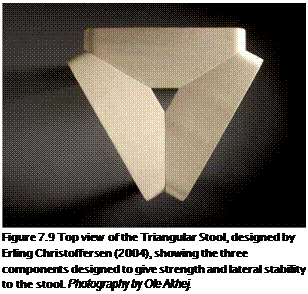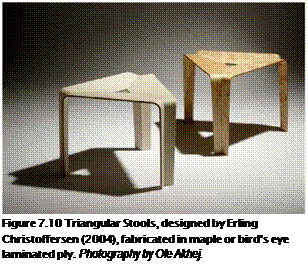What are the material properties that furniture designers need to consider? What environmental conditions or structural characteristics influence the decision to use a specific wood or plastic in design? How might leather’s ability to absorb odor, moisture, and oils affect the decision on whether or not to use it? Considering material properties is integral to the design process. Some important technical matters arise when the following questions are raised:
How much do materials expand or contract when exposed to environmental changes in humidity or temperature? This can help establish an index to quantify a material’s stability and its structural qualities.
How well do materials wear and age?
 ■ Might a material’s perceived "warmth" or "comfort" guide its use in a specific application?
■ Might a material’s perceived "warmth" or "comfort" guide its use in a specific application?
 Materials respond to changes in the environment in different ways. Wood expands and contracts with changes in relative humidity and tends to darken over time when exposed to UV radiation (daylight). Metals expand and contract when the temperature changes, and most metals such as aluminum and copper will develop a protective patina when exposed to air and moisture, while other metals such as unprotected steel, will rust. Leather is affected by temperature, daylight, and moisture changes. Plastic can be affected by ultraviolet (UV) radiation (full-spectrum light) as well as temperature. Acrylonitrile butadiene styrene (ABS) is a thermoplastic that is sensitive to fading and becomes brittle when exposed to daylight, while polypropylene plastic is less reactive to daylight, making it more suitable for exterior applications. Concrete never completely cures, glass is always slumping, and organic materials decompose. All materials undergo some degree of creep (deflection) when subjected to a uniform load or applied force.
Materials respond to changes in the environment in different ways. Wood expands and contracts with changes in relative humidity and tends to darken over time when exposed to UV radiation (daylight). Metals expand and contract when the temperature changes, and most metals such as aluminum and copper will develop a protective patina when exposed to air and moisture, while other metals such as unprotected steel, will rust. Leather is affected by temperature, daylight, and moisture changes. Plastic can be affected by ultraviolet (UV) radiation (full-spectrum light) as well as temperature. Acrylonitrile butadiene styrene (ABS) is a thermoplastic that is sensitive to fading and becomes brittle when exposed to daylight, while polypropylene plastic is less reactive to daylight, making it more suitable for exterior applications. Concrete never completely cures, glass is always slumping, and organic materials decompose. All materials undergo some degree of creep (deflection) when subjected to a uniform load or applied force.
Material properties are important to consider when selecting material for furniture. The beauty of materials should be integrated with performance, purpose, and use. Consider the stool designs by Erling Christoffersen for their poetic use of materials that perfectly suit the performance requirements (Figures 7.9 and 7.10). The three uniform, molded elements create both seat and legs. The seat’s shape results from joining and tilting the three elements toward one another, creating both comfort and resistance to lateral forces due to the angular cross-section of the legs. The open triangular space in the seat pan serves as a handle for the stool.
Characteristics of material can be quantitative (measurable), and qualitative (perceived through the senses). A material’s performance in furniture is a relative matter. How well materials perform is influenced by many considerations grounded by technical material properties and descriptive characteristics. As a matter of introduction, consider the influence that the following material properties and characteristics have on the form and utility of furniture:
■ Absorptive quality
■ Aging and weathering
■ Cellular structure (open cell or closed cell)
■ Compressive and tensile strength
■ Density
■ Dimensional movement
■ Ductility
■ Durability
■ Elasticity
■ Expandability
■ Haptic sensations
■ Moisture resistance
■ Stability
■ Surface qualities
■ VOCs
■ Workability
■ Other aspects



